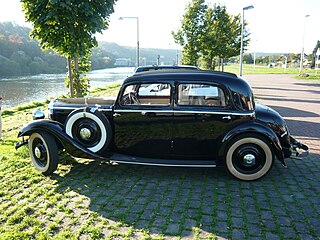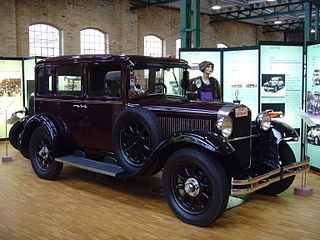
The Audi 80 is a compact executive car produced by the Audi subdivision of the Volkswagen Group across four generations from 1966 to 1996. It shared its platform with the Volkswagen Passat from 1973 to 1986 and was available as a saloon, and station wagon — the latter marketed by Audi as the Avant. The coupé and convertible models were not badged as members of the range, but used a derivative of the same platforms.

The Peugeot 601 was a range-topping car produced between 1934 and 1935 by Peugeot. It had its formal launch on 5 May 1934 and marked a return by the manufacturer to six-cylinder engines.

The Adler Diplomat is a substantial six-cylinder “limousine” (saloon) built by the Frankfurt auto-maker, Adler. It was introduced in March 1934 as a direct replacement for the manufacturer's Standard 6. Less directly the six-cylinder Diplomat also replaced the Adler Standard 8 since Adler's large eight-cylinder car was discontinued in 1934 without a direct replacement of its own.

The Mercedes-Benz Mannheim 350 replaced the W03/Typ 350 models in 1929. The structure originated by Ferdinand Porsche was modified by Hans Nibel.

Initially presented early in 1933, the Audi Front UW 220 was Europe’s first car to combine front-wheel drive with a six-cylinder engine. It remained in production for slightly under two years before being replaced by the Audi Front UW 225 featuring a larger 2.25-litre engine. The larger-engined car introduced in 1935 was built till April 1938 and continued to be listed into 1939. Between 1933 and 1938, the Front was the only Audi in volume production.

The Wanderer W21 was a middle-class six-cylinder sedan introduced by Auto Union's Wanderer company in 1933. The W21 replaced the Wanderer W17, from which it inherited its ohv engine. The car shared its chassis with the more powerful Wanderer W22, but its engine was smaller.

The Mercedes-Benz W15 is an automobile produced by Mercedes-Benz from 1931 to 1936. Regarded today as a mid-size family car, it was given the chassis designation W15, and sold as the Typ 170 in four-door "Limousine" (sedan/saloon) and Cabriolet forms.

The Mercedes-Benz 380 is an eight-cylinder powered automobile introduced by the German manufacturer Mercedes-Benz at the Berlin Motor Show in February 1933. It was withdrawn from production during 1934. Several models with similar names were produced by Mercedes-Benz during the 1930s, so that in retrospect the car is frequently identified using the manufacturer's Works Number as the W22.

The DKW Typ 4=8 is a small rear-wheel drive two-stroke V4 engined car produced at the company's Spandau plant by DKW. It was launched at the Berlin Motor-show in 1929 as a successor to the DKW Typ P built at the same factory, although the DKW Typ P 4=8 was significantly larger than the Typ P: in terms of market positioning a more direct successor to the DKW Type P was probably the DKW F1 produced in Zwickau from 1931.

The Mercedes-Benz W 153 was a luxury six cylinder passenger car built in parallel with the W 143 from 1938, and first presented in public at the Berlin Motor Show early in 1939. It was one of several Mercedes-Benz models known, in its own time, as the Mercedes-Benz 230.

The Mercedes-Benz Typ 230 n was introduced by Mercedes-Benz in 1937 as a successor to the Typ 230 . It was one of several models over the space of nearly eight decades to be sold with a name along the lines "Mercedes-Benz 230", and is therefore in retrospect more normally named according to its internal works designation as the Mercedes-Benz W 143.
The Adler Standard 8 is a large passenger car introduced in 1928 by the Frankfurt auto-maker, Adler. It was a big eight cylinder “limousine” (saloon) closely modelled on the manufacturer’s Standard 6 which had first appeared in public in October 1926. However the Standard 8 had a longer 3,325 mm (130.9 in) wheelbase as well as a 50 mm (2.0 in) wider track. Although it closely resembled the Standard 6, the Standard 8 was larger all round. The Standard 8 engine had eight cylinders, but individually the cylinder dimensions, at 75 mm (3.0 in) x 110 mm (4.3 in), were identical to those on the six cylinder car as well as on the four cylinder with the Adler Favorit which appeared in 1929.

The Adler Primus is a small family car introduced by the Frankfurt based auto-maker, Adler in March 1932. In a move reminiscent of British Leyland in the 1970s, Adler launched two similarly sized cars in the same year, one of which followed the then new trend set by DKW for front-wheel drive, and one respecting the conventional rear-wheel drive configuration still used by the market leader, Opel.

The Adler Trumpf is a small family car introduced by the Frankfurt based auto-maker, Adler in March 1932, with Trumpf production fully starting in the late summer that year. In a move reminiscent of British Leyland in the 1970s, Adler launched two similarly sized cars in the same year, one of which followed the 1931 DKW F1's then innovative front-wheel drive layout, and the other model using the conventional rear-wheel drive configuration still used by then market leader, Opel's 1.2 litre 'model 6'.

The Opel 1,2 Liter is a small car manufactured by Opel between 1931 and 1935. The 1,2 Liter was replaced in 1935 by the Opel P4 which was broadly similar but employed a new engine and continued in production until December 1937. For just one year, in 1933, the manufacturer also offered the Opel 1,0 Liter which was a smaller engined version of the 1,2 Liter. The Opel 1,2 Liter replaced the last version of the Opel Laubfrosch and was itself first complemented and then effectively replaced by the more roomy Opel Kadett, which had itself already entered production in 1935.

The Mercedes-Benz W 21 was a six-cylinder passenger car launched in 1933 using the name Mercedes-Benz Typ 200. It was one of several Mercedes-Benz models known, in its own time, as the Mercedes-Benz 200 and is therefore in retrospect more commonly referred to using its Mercedes-Benz works number, “W21”.

The Mercedes-Benz W 142 was a six-cylinder passenger car launched in February 1937, as a successor to the Mercedes-Benz Typ 290. The car was known by its name Typ 320 at the time of its production and service, but is in retrospect commonly referred to using its Mercedes-Benz works number, "W142", which gives a more unambiguous, unique nomenclature.

The Mercedes-Benz W18 was a six-cylinder automobile introduced as the Mercedes-Benz Typ 290 in 1933. It was a smaller-engined successor to the manufacturer’s Typ 350 / 370 Mannheim model. In terms of the German auto-business of the 1930s it occupied a market position roughly equivalent to that filled by the Mercedes-Benz E-Class in the closing decades of the twentieth century. The W18 was replaced in 1937 by the manufacturer’s W142.

The Mercedes-Benz W11 was a midsize six-cylinder automobile introduced by Daimler-Benz it 1929. It was developed from the Mercedes-Benz W02 first seen in 1926, and the W11 shared its chassis and bodywork with the W02, but the W11 came with a larger more powerful engine, a new name and a wider list of “standard bodies” from which customers could choose.

The Nervastella is a large automobile constructed by Renault between 1930 and 1937. It was used as a state car and pictures of the president of the French Republic sitting in a Nervastella can therefore be seen in newsreels from the mid-1930s.



















